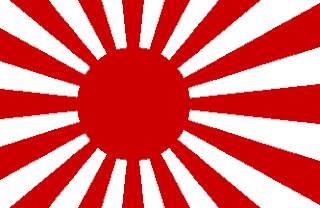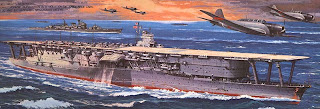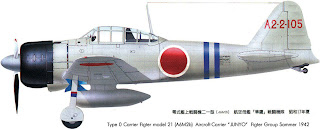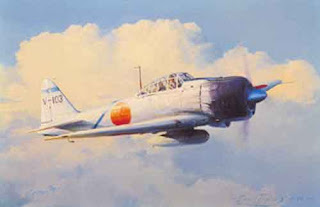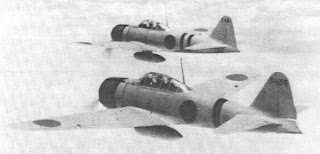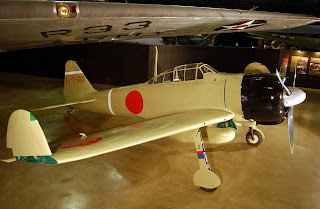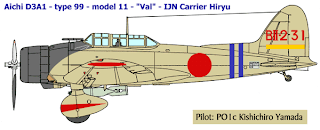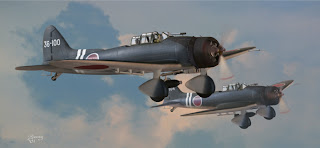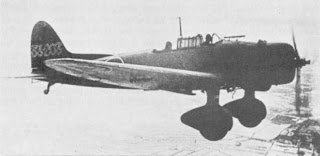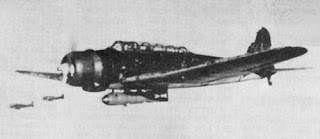Flightdeck Friday: Countdown to Midway – IJN Carrier-based Air Order of Battle (AOB)
First Carrier Striking Force
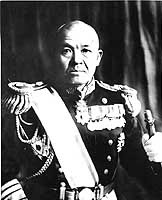 VADM Nagumo Chuichi
VADM Nagumo Chuichi
Chief of Staff: RADM Kusaka Ryunosuke
Carrier Division 1 – VADM Nagumo
Akagi (flagship) – Captain Aoki Taijiro, commanding
18 x A6M2 carrier fighters (aka Zero)
18 x D3A1 carrier bombers (aka Val)
18 x B5N2 carrier attack aircraft (aka Kate)
6 x A6M2 fighters (6th Air Group)
Kaga – Captain Okada Jisaku, commanding
18 x A6M2
18 x D3A1 27 x B5N2
9 x A6M2 (6th Air Group)
2 x D3A1 (cargo for Soryu)
Carrier Division 2 – RADM Yamaguchi Tamon
Hiryu (flagship) – Captain Kaku Tomeo, commanding
18 x A6M2
18 x D3A1
18 x B5N2
3 x A6M2 (6th Air Group)
18 x A6M2
16 x D3A1
18 x B5N2
3 x A6M2 (6th Air Group)
2 x D4Y1 carrier bomber (experimental reconnaissance aircraft)
The Mitsubishi A6M Zero ("A" for fighter, 6th model, "M" for Mitsubishi) was a light-weight, carrier-based fighter aircraft employed by the Imperial Japanese Navy Air Service from 1940 to 1945. At the time it was introduced, the Mitsubishi A6M was the best carrier-based fighter plane in the world and was greatly feared by Allied pilots.
Widely known as the Zero (from its Japanese Navy designation, Type 0 Carrier Fighter – Rei shiki Kanjo sentoki, 零å¼è‰¦ä¸Šæˆ¦é—˜æ©Ÿ), taken from the last digit of the Imperial year 2600 (1940), when it entered service, in Japan it was unofficially referred to as both Rei-sen and Zero-sen.
“I had full confidence in my ability to destroy the Grumman and decided to finish off the enemy fighter with only my 7.7mm machine guns. I turned the 20mm. cannon switch to the ‘off’ position, and closed in. For some strange reason, even after I had poured about five or six hundred rounds of ammunition directly into the Grumman, the airplane did not fall, but kept on flying. I thought this very odd – it had never happened before – and closed the distance between the two airplanes until I could almost reach out and touch the Grumman. To my surprise, the Grumman’s rudder and tail were torn to shreds, looking like an old torn piece of rag. With his plane in such condition, no wonder the pilot was unable to continue fighting! A Zero which had taken that many bullets would have been a ball of fire by now.”
The definitive version of the Zero was the A6M2 Type 0, Model 21 which saw 740 completed by Mitsubishi and another 800 by Nakajima. This was the version that escorted the attack at
General characteristics (A6M2, Type 0, Model 21):
* Crew: 1
* Length: 9.06 m (29 ft 9 in)
* Wingspan: 12.0 m (39 ft 4 in)
* Height: 3.05 m (10 ft 0 in)
* Wing area: 22.44 m² (241.5 ft²)
* Empty weight: 1,680 kg (3,704 lb)
* Loaded weight: 2,410 kg (5,313 lb)
* Max takeoff weight: kg (lb)
* Powerplant: 1× Nakajima Sakae 12 radial engine, 709 kW (950 hp)
* Aspect ratio: 6.4
Performance
* Never exceed speed: 660 km/h (356 knots, 410 mph)
* Maximum speed: 533 km/h (287 knots, 331 mph) at 4,550 m (14,930 ft)
* Range: 3,105 km (1,675 nm, 1,929 mi)
* Service ceiling: 10,000 m (33,000 ft)
* Rate of climb: 15.7 m/s (3,100 ft/min)
* Wing loading: 107.4 kg/m² (22.0 lb/ft²)
* Power/mass: 294 W/kg (0.18 hp/lb)
* Guns:
– 2× 7.7 mm (0.303 in) machine guns in the engine cowling
– 2× 20 mm (0.787 in) cannon in the wings
* Bombs:
– 2× 66 lb (30 kg) and
– 1× 132 lb (60 kg) bombs or
– 2× fixed 250 kg (550 lb) bombs for kamikaze attacks
First flown in 1938 and deployed in 1940, in the first ten months of WWII the Aichi D3A (99å¼è‰¦ä¸Šçˆ†æ’ƒæ©Ÿ, Allied code name Val) accounted for more shipping sunk than any other aircraft in any other theater. The outcome of a competition between Achi and Nakajima, the Val’s design was inspired in part by e elliptical wings of the Heinkel He70 and the fuselage was similar to that of the Zero (though strengthened for stresses of dive bombing). Drag at the rather sedate speeds the Val would operate at was not as great a factor, so the gear was fixed and faired.
In December 1939 the Navy ordered the aircraft as the Navy Type 99 Carrier Bomber Model 11. The production models featured slightly smaller wings and increased power – the directional instability problem was finally cured with the fitting of a long dorsal fin, making it highly maneuverable.
Armament was two forward-firing 7.7 mm Type 97 machine-guns, and one flexible 7.7 mm Type 92 machine gun in the rear cockpit for defense. Normal bomb load was a single, trapeze-mounted 550 lb bomb. Two additional 130 lb bombs could be carried on wing racks located under each wing outboard of the dive brakes.
Starting with the attack on Pearl Harbor, the D3A1 took part in all major Japanese carrier operations in the first ten months of the war, but it was their attacks on the cruisers HMS Cornwall and HMS Dorsetshire and the carrier HMS Hermes in an
The version faced at Midway was the D3A1. Specifications:
General characteristics
* Crew: Two, pilot and gunner
* Length: 10.2 m (33 ft 5 in)
* Wingspan: 14.37 m (47 ft 2 in)
* Height: 3.85 m (12 ft 8 in)
* Wing area: 34.9 m² (375.6 ft²)
* Empty weight: 2,408 kg (5,309 lb)
* Max takeoff weight: 3,650 kg (8,047 lb)
* Powerplant: 1× Mitsubishi Kinsei 44 , 798 kW (1,070 hp)
Performance
* Maximum speed: 389 km/h (231 knots, 242 mph)
* Range: 1,472 km (795 nm, 915 mi)
* Service ceiling: 9,300 m (30,500 ft)
Armament
* 2 forward 7.7 mm (0.303 in) Type 97 Light Machine Guns
* 1 rear 7.7 mm (0.303 in) Type 92 Heavy Machine Gun
* 1 × 250 kg (550 lb) or 2 × 60 kg (130 lb) bombs
Two aircraft designed, built and flown within a year of each other on opposite sides of the Pacific – the TBD Devastator for the
Early operations in the war against
General characteristics
* Length: 10.30 m (33′ 10")
* Wingspan: 15.52 m (50′ 11")
* Height: 3.70 m (12′ 2")
* Wing area: 37.7 m² (406 ft²)
* Empty weight: 2,279 kg (5,024 lb)
* Loaded weight: 3,800 kg (8,380 lb)
* Max takeoff weight: 4,100 kg (9,040 lb)
* Powerplant: 1× Nakajima Sakae 11 radial engine, 750 kW (1,000 hp)
Performance
* Range: 1,935 km (1,202 mi)
* Service ceiling: 8,260 m (27,100 ft)
* Rate of climb: 6.5 m/s (1,283 ft/min)
* Wing loading: 101 kg/m² (21 lb/ft²)
* Power/mass: 0.20 kW/kg (0.12 hp/lb)
Armament
* Bombs: 1x 800 kg (1,760 lb)type 91 torpedo or 3x 250 kg (550 lb) bombs or 6 x 60 kg (132 lb)

